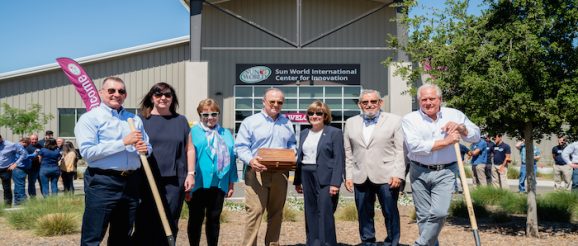Sun World’s Center for Innovation paves the way for developing premium genetics – FreshFruitPortal.com

On Friday June 3, Sun World International opened its doors in an invitation to take a “first look” at its new Center for Innovation.
The company’s CEO & President David Marguleas and EVP Chief Science Officer Jennifer Petersen told FreshFruitPortal.com about the center’s role, through its technology and innovation, in the company’s transformation from a vertically integrated farming company to an IP and genetics company.
Center for Innovation
Although Sun World had a virtual opening in December 2020, Marguleas spoke of the event being “the first opportunity to open our doors and welcome our customers and the local community to see where all of this great, flavorful fruit originates.”
With the company making the decision to make a shift from production to genetics and breeding three years ago, its President described the facility as “the culmination of that transformation as a business”, as it has been four years in the making.
The innovation center will use all the latest technology and innovation, as well as a talented and experienced breeding team to develop fruit varieties that are not only more “nutritious and flavorful”, but are also more “climate resilient.”
The new fruit showroom, which opens out onto the table grape vineyards, “is a wonderful way to welcome growers, supermarket retailers and fruit marketing representatives to our facility in a more hospitable environment, to show them the fruits of our labors, as well as to get feedback from them, to evaluate the work that we’re doing”, according to Marguleas.
Technology
With both climate change and food security being of global concern, Sun World recognizes the importance of breeding fruit varieties that require less water, fewer crop inputs and that can be grown in non-traditional areas.
Chief Science Officer Jennifer Petersen highlighted that “as the climate becomes more variable […] our ability to create really resilient varieties that […] can be produced in warmer and drier climates that have less available water, is really what we’re focusing on in terms of the next generation of varieties for all of our crops.”
She believes that the facility’s tools and technologies will make the difference when breeding for traits like water use and efficiency, characteristics that will be critical for maintaining fruit production as the climate changes.
“Genetically speaking those are more complicated traits to reach for and so that’s where some of the new technologies can help us make gains […] because the agriculture that we have today is going to really change even in the next five to ten years, and beyond”, she explained.
When it comes to developing new varieties, cherries appear to be at the top of Sun World’s agenda, as it recently announced a new research partnership with Washington State University to share and study genetic material from promising varieties.
The company’s CEO confirmed that “fresh cherries are one of our current focal points, so we are looking for some really incredible, new cherry varieties to come from the new Sun World facility for cherry growers in both the Southern Hemisphere and the Northern Hemisphere to benefit from.”
Although cherries are popular in a number of major fruit consuming markets like Asia and North America, they are also a fruit that can only be grown in very specific regions with particular growing conditions, such as Chile, South Africa and California.
For this reason, Sun World is aiming to develop varieties that can be grown in non-traditional cherry growing regions in order to have more continuous supplies of the fruit which can meet supermarket customers’ needs.
The idea is to “enable growers to be able to produce them at times of the year when cherry supply is low and demand for fresh, flavorful cherries is high”, said Marguleas.
Therefore, Sun World is looking to grow particularly versatile and “climate resilient cherries”, but also considers “normal traits” like “high flavor, texture, optimum color, size, harvest and shelf life” when developing new varieties.
Jennifer Petersen concluded: “The opening of our center for innovation really marks our commitment to the future of our industry and our commitment to provide premium genetics across our core crops, as well as a potential expanded crop portfolio.”
